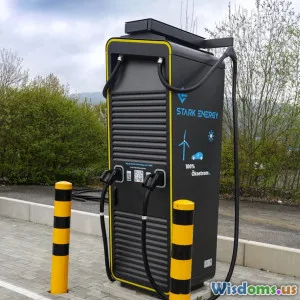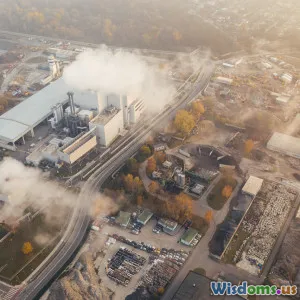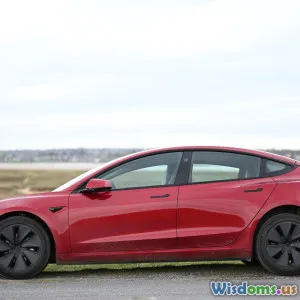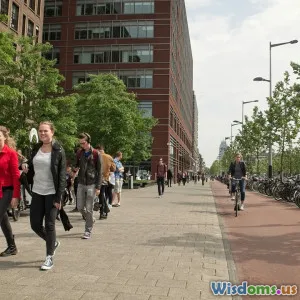
Hybrid Cars vs Public Transit Which Wins for Lower Emissions
11 min read An in-depth comparison of hybrid cars and public transit impacts on emissions to find the greener choice. (0 Reviews)
Hybrid Cars vs Public Transit: Which Wins for Lower Emissions?
Transportation accounts for a significant portion of global carbon emissions, directly fueling climate change and urban pollution. Faced with these challenges, governments, city planners, and individuals grapple with the dilemma: how to navigate toward cleaner transportation options. Among the choices often debated, hybrid electric cars and public transit stand out as prominent contenders for reducing carbon footprints. But which option truly wins in the race for lower emissions? This comprehensive analysis dives into lifecycle emissions, operational efficiencies, contextual factors, and real-world examples to unravel the answer.
Understanding the Stakes: Why Emissions Matter in Transportation
Transportation accounts for approximately 29% of total greenhouse gas emissions in the United States, making it the largest emitter among sectors, according to the U.S. Environmental Protection Agency (EPA). Globally, the International Energy Agency (IEA) reported that CO2 emissions from transport reached about 8.6 gigatons in 2021. These emissions primarily arise from burning fossil fuels in vehicles, significantly contributing to urban air pollution, health hazards, and climate disruption.
Reducing emissions is essential not only to meet international climate goals under the Paris Agreement but also to improve urban air quality where millions suffer from respiratory diseases linked to traffic pollution. The choice between private hybrid vehicles and public transit systems is central to this reduction effort.
What Are Hybrid Cars? A Closer Look at Their Emissions Profile
Hybrid cars combine an internal combustion engine (usually gasoline) with an electric motor and battery system. They operate on electric power at low speeds and switch to gasoline or combine both to optimize fuel efficiency.
Lifecycle Emissions of Hybrid Cars
- Manufacturing Impact: Producing hybrid vehicles generally results in higher initial emissions compared to conventional cars due to complex batteries. Estimates suggest manufacturing a hybrid car can create about 15-20% more CO2 emissions than a comparable gasoline vehicle.
- Fuel Efficiency Gains: However, their superior fuel economy compensates over time. According to the Union of Concerned Scientists, hybrids can reduce fuel consumption by 20-35% compared to standard combustion vehicles.
- Operating Emissions: The EPA notes that hybrid models like the Toyota Prius emit roughly 90 grams of CO2 per mile, compared to about 160 grams for traditional gasoline cars.
Real-World Benefits and Considerations
Hybrid cars provide flexibility and convenience, especially in regions with limited public transit infrastructure. They encourage drivers toward cleaner mobility without requiring behavior change. However, total emissions savings depend heavily on driving patterns, energy sources for electricity (when plugged in for charging in some hybrids), and vehicle maintenance.
Public Transit: Emissions Per Rider and Stage Efficiency
Public transit includes buses, trains, subways, and trams. Its sustainability advantage relies on transporting multiple passengers simultaneously, thus sharing emissions across many users.
Emission Statistics for Public Transit
- Per Passenger Mile Emissions: The American Public Transportation Association (APTA) reports that public transit emits an average of 33 grams of CO2 per passenger mile, significantly lower than private vehicles.
- Infrastructure Impacts: Production and maintenance of transit vehicles and infrastructure have upfront emissions, but amortized over millions of passenger trips, these are comparatively low per capita.
- Electric and Hybrid Buses: Many cities adopt hybrid, electric, or hydrogen fuel cell buses, further reducing emissions. For instance, Los Angeles Metro introduced over 200 electric buses, cutting their transit system's emissions by 30%.
Operational Efficiencies
Efficiency varies by system and capacity utilization. Full buses and trains maximize benefits, while off-peak or underused services can have higher emissions per rider.
Real-world studies, such as those by the International Association of Public Transport, show cities with robust transit systems emit about 45% less CO2 per capita than comparable car-dependent cities.
Hybrid Cars vs Public Transit: Side-by-Side Emissions Comparison
| Aspect | Hybrid Cars | Public Transit |
|---|---|---|
| Emissions per mile | ~90 grams CO2 (EPA estimate) | ~33 grams CO2 per passenger mile |
| Manufacturing emissions | Higher due to battery production | Infrastructure and vehicle amortized |
| Energy source dependency | Gasoline + electric battery (hybrid) | Diesel/electric/hybrid/electric buses and trains |
| Occupancy impact | Typically 1-2 passengers | Often 20-50+ passengers |
| Convenience | Private control, flexible routes | Fixed routes and schedules |
| Typical use impact | Lower city congestion but individual use | Reduces congestion and traffic |
Key Insight: Public transit has the clear edge in emissions per passenger mile, provided adequate ridership levels. However, hybrid cars still outperform conventional gasoline vehicles and can be more practical where transit is inefficient.
Additional Factors Influencing Emissions Impact
Urban Density and Geography
High-density cities like New York and Tokyo benefit enormously from public transit due to shorter distances and high ridership. Conversely, sprawling cities like Los Angeles may see less transit efficiency, making hybrid cars more beneficial emissions-wise in some contexts.
Energy Grid Cleanliness
As electric grids decarbonize, hybrid and electric vehicles will owe more to cleaner electricity. Similarly, electric public transit systems gain greater environmental benefits as grids improve.
Behavior and Policy
Government incentives, congestion pricing, bike lanes, and walkability also play roles. Citizens combining transit with last-mile electric vehicles or car-sharing amplify emissions savings.
Real-World Examples Highlighting Impact
- Vienna, Austria: The city boasts a world-class transit network with high ridership and low emissions, resulting in CO2 per capita nearly half the European average.
- California, USA: The state promotes hybrids alongside expanded electric bus fleets and light rail, achieving substantive emissions declines despite suburban geography.
- Singapore: Offers excellent public transit intertwined with tight vehicle ownership controls, achieving some of the world’s lowest transport emissions per capita.
Conclusion: Which Wins for Lower Emissions?
While hybrid cars represent a significant improvement over traditional vehicles and provide indispensable mobility options in many contexts, public transit consistently outperforms hybrids regarding emissions per passenger mile—particularly where systems are well-utilized and electrified.
The ideal path for sustainable transportation fosters a synergistic approach: expanding and modernizing public transit, investing in cleaner vehicle technologies (including hybrids), integrating smart urban planning, and incentivizing behavioral shifts.
Each mode contributes to a cleaner future, but to drastically reduce emissions, widespread adoption of public transit and prioritization of zero-emission transit fleets present the clearest route forward. Empowering communities with accessible, affordable, and efficient transit will ultimately win the emissions race.
Data Sources:
- U.S. Environmental Protection Agency (EPA)
- American Public Transportation Association (APTA)
- Union of Concerned Scientists
- International Energy Agency (IEA)
- International Association of Public Transport
Takeaway: If your goal is minimizing your personal transportation emissions and your city has reliable public transit, hopping on the bus or train is likely greener than driving even the best hybrid car. Where transit gaps exist, hybrids offer a clean alternative—together shaping a promising low-emission future.
Rate the Post
User Reviews
Popular Posts




















